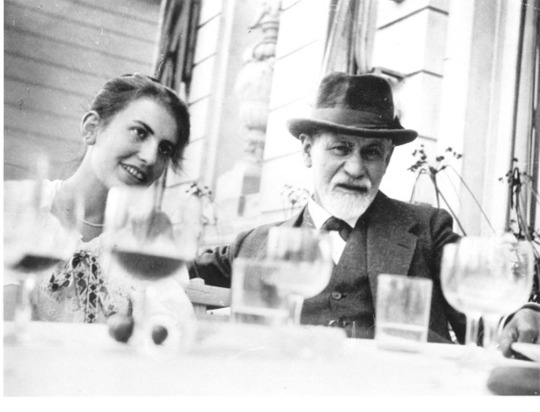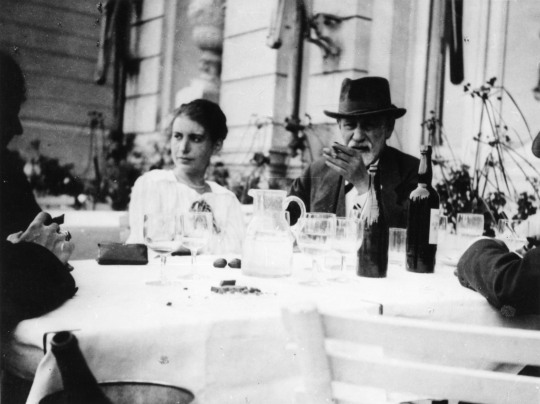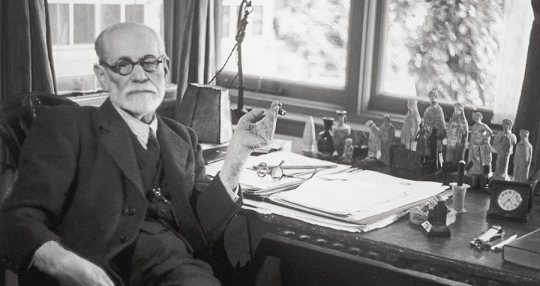#get creative. add some freudian psychoanalysis
Text
(miranda priestly voice) soup for jiang yanli's main quality? groundbreaking
#hewwo#🙄 but what did i ever expect from fujos#not just with her but with these fandoms in general it's always the lowest hanging fruit#get creative. add some freudian psychoanalysis
10 notes
·
View notes
Text
I've Often Toyed with Sigmund Freud
“What good is a newborn baby?”
That’s Benjamin Franklin, just outside Paris one afternoon at a technology demonstration in August, 1783. He allegedly offered this riposte to a skeptical onlooker who wondered aloud how, in any way, could there be value in the hot air balloon rising from the ground in front of them and hundreds of other onlookers. Ambassador Franklin’s now famous bon mot chiseled another deft and surprisingly fecund bit of wit into the history books. He would have said it in French: “A quoi bon l’enfant qui vient de naître?” (I wasn’t there, of course, but it would have come out something like that.)
The origin of things does not necessarily foretell how they will evolve or transform in the future. When that globe aérostatique rose into the French sky that late 18th century afternoon, nobody could have predicted thousands of flights a day in metal airships, movies playing privately at each seat, and overpriced beer available in plastic cups served from rolling carts. Ideas don’t typically evolve elegantly from point to point like dainty caterpillars declaring the time has come for unfurling new wings. Ideas crash and careen like seedlings caught in unpredictable zephyrs, slapping into unexpected obstructions, carried long distances in clear air, tumbled like refuse until they take root in unexpected cracks in unloved pavement. Most seeds die.
The few that thrive are the ones that have a chance of catching our attention. But even in full bloom, the cold reality is that most of the time we don’t give a moment’s thought to their unexpected, unpredictable origins.
“How do you feel?”
Sigmund Freud is essentially a relic of intellectual antiquity in terms of modern psychotherapy, an anachronism. Freud’s early thinking about the mind, the unconscious, and the way people develop their own personalities, however, largely ignited the modern study of how people think about themselves and their relationships with others. The fact that the practical value of his work is now forehead-smackingly obtuse and effectively useless does not impugn the radical thinking it must have taken for him simply to generate his ideas when he had them. His ideas weren’t only new, they were spectacularly inventive. (We could also add “ridiculous”, but that doesn’t dispel their imaginative energies, misguided though they may be.) In the many decades following his work, social science continues to present dramatically different views about human development, personality, and interpersonal relations. Some of those paradigmatic changes are profound, including imperative repudiations of his deeply ingrained misogyny, lack of scientific rigor, obsession with bizarre symbolism, and so much more. But Freud matters simply for asking what others hadn’t asked as clearly at the time. Sure, he was mostly wrong, but in terms of this essay’s particular consideration, that’s really not the point. The world of modern psychotherapy is nothing like the world Freudian psychoanalysis, but we cannot forget the spark of inquiry that provoked profoundly more relevant growth in the field, even if we reject it its initial precepts and conclusions.
Franklin, again: “What good is a newborn baby?” If we’re talking about a creative initiative you’re developing, whatever it may be, there is precisely zero value to your work if you time horizon is too short. It’s hard to know what will grow from your labors, or what may provoke radically transformative growth in others. You can guess, you can extrapolate, but you can’t know. What you can do is stay with your project and find out what happens.
It’s tricky, though. Staying with dead-end ideas too long gets you hot air balloons that go up, come down, and effectively go nowhere. You have to know when to abandon something and move on. What matters more is determining if you’re on to something worth pursuing. Then it’s up to you to chase it like a leopard chases lunch if you ever want it to matter. You don’t have to know exactly what might grow from your work, and it’s possible that history may recall that you weren’t the person to coax its most profound value into bloom. But once committed to creating something new, you’re automatically committed to that new thing taking on a life of its own.
@michaelstarobin
facebook.com/1auglobalmedia
0 notes
Photo

the architecture of a problem – psychoanalysis and creative practice
Mike Eden
An Interview with Professor Malcolm Quinn
Psychoanalysis has the character of a Promethean wound in that it has survived so many debunking’s and re-interpretations to grow back and undergo another renewal and return to its foundations in a rhythm that would more than likely amuse its founder.
It is now approximately one hundred and twenty years since Freud formulated his ideas and created psychoanalysis, since that point Freud’s dream of widespread acceptance of his theory has never fully come to pass but despite continued attacks from alternate theoretical frameworks and threatened irrelevance from the brain sciences Freud’s ideas persist and offer serious challenges to the would be usurpers.
In the arts psychoanalysis proves a compelling subject for or companion to art making inspiring first the Surrealists and subsequently such significant artists as Louise Bourgeois, Antony Gormley and Damian Hirst to name a few, however since the most scathing and convincing criticism of surrealism came from Freud himself we can safely say that incorporating psychoanalysis is always problematic.
To explore if this is a necessary problem Professor Malcolm Quinn shares his thoughts on psychoanalytic approaches in art and design.

M Eden: One of the first things I wanted to ask you about is an idea that you introduce in ‘Knowing Nothing Staying Stupid,’ the fall of knowledge, you relate this to the relationship in psychoanalysis between the analysand and the analyst, this is a difficult point for people to accept since we are often led to believe that knowledge is power.
M Quinn: The first thing to say is that I wrote that book with professor Dany Nobus of Brunel university and it was very much a joint effort, the thing we were most keen to point out in the book was that the only knowledge that’s at stake in psychoanalysis is unconscious knowledge, that psychoanalysis its self doesn’t represent a coherent body of knowledge that you then apply either to someone in the clinical situation or to an art work or something else, but really the whole point of psychoanalysis is to put ones-self as analyst in the position to receive whatever is emerging from the unconscious of the analysand[1]. As Freud pointed out in his introductory lectures the whole point of psychoanalysis is that the analyst knows nothing! This is a hard point to accept because this suggests that if you don’t know anything then you can’t do any interpretation, you can’t do any interpretation because the interpretation is being done by the analysand who is constantly interpreting whatever is in tension in the unconscious,
M Eden: A lot of artists have an interest in the unconscious, but you have said that the nature of this is often misinterpreted by creatives in what sense?
M Quinn: The unconscious isn’t a lumber room full of stuff, the unconscious is what is currently impossible in your life because your life is set up in a certain way, the unconscious is what is implicit but not allowed or in some way repressed, foreclosed or forbidden in the way a person’s life is currently constructed. So what is unconscious emerges precisely as a fall of knowledge, of knowledge of one’s self, so even as your aiming to make a definitive statement something trips you up you have a slip of the tongue and that slip of the tongue represents the fall of knowledge in so far as it’s the fall of explicit conscious knowledge into the realm of unconscious knowledge, it’s like the truth of unconscious knowledge appearing within the conscious effort to make a definitive statement. This is also why in psychoanalysis the ‘truth’ isn’t teleological, it’s not about the end, you don’t get the truth at the end, the truth emerges as cause, the truth is what caused you to make a slip of the tongue, the truth is what causes you to do something out of the ordinary. The unconscious truth is what emerges in symptoms in types of behaviour and out of the refusal to accept certain potentialities and possibilities. It’s not as if psychoanalysis is about being clever or stupid but the impossibility of being clever because even as you set yourself up to be clever the unconscious is going to find a way to emerge in ways you don’t expect.
M Eden: How do you help someone to understand that who is of the opinion that knowledge is empowering, the more I have the better off I am, the more options I have, the better I am at accessing aspects of society. People see themselves as needing this to be able to move forward to be employable or tackle problems that emerge.
M Quinn: I suppose I might say for example if you know more and more and more about the recent financial crisis and more and more and more about bankers bonuses does that actually help you to get any agency or grip on this world? It simply gives you more and more information and adds to a sense of being powerless to affect anything in anyway, so yes we are taught at school that knowledge acquisition is a good thing but we constantly come up against situations in life where the more knowledge you gain the more embedded you are in the situation your trying to escape.
M Eden: In what sense then do you feel people get this wrong when they try to use the unconscious in their work or as a subject for art?
M Quinn: The point about the unconscious is that it doesn’t emerge where you want it to, it emerges within close attention to structures of speech and language and I’m particularly interested in the construction of speech and knowledge and understanding in an art and design context. For example at the Tate (during the Turner prize) I saw that they had asked people to write down comments on post it notes and stick these to the wall so everyone could see them, it was an attempt to democratise the commentary on art, someone had written, ‘ what is the function of artists in society? I still don’t know after this exhibition!’ I thought that was a great question because you might say that in the art world, artists/critics and curators are always functioning but are they acknowledging their function? Do they know how they’re functioning?

M Eden: In what way does psychoanalysis help us to understand this blank spot?
M Quinn: In a strictly Freudian sense if the analyst knows nothing and the person being analysed knows something but doesn’t know they know it, because its unconscious/repressed, in this sense artists/art institutions could claim they know how there functioning and perhaps on some level they do but they don’t know how they know it and the ways that this knowledge prevents them from really seeing how they fit into society or a broader picture, for example perhaps they see themselves free of function there not a part of the system there above it commenting on it in a very self-aware way,
M Eden: Like the supposed openness of the Tate to ask people to display their opinions, as if it’s the opinion that really matters rather than simply standing for openness itself with no real agency offered?
M Quinn: Exactly, then someone comes along like a Lacanian hysteric talking to the master and says ‘I don’t know how you’re functioning! Tell me how you’re functioning!’ that I would say is the emergence of the unconscious because it’s about the construction of discourse it’s about the point where something emerges which reveals a point of impossibility it shows an obstacle or a difficulty of speech, ‘Tell me how you’re functioning!’... ‘No I can’t, I don’t function! I’m not part of a system I’m a free agent!’
M Eden: Would you say then that knowledge of psychoanalysis prevents a person taking too grand a position and forces them to reflect on the implications of their work?
M Quinn: Well it makes me think about a film ‘The Five Obstructions’ by Lars Von Trier, in some ways it’s a drama where the son kills the father, Von Trier goes back to his old mentor Jørgen Leth and says, ‘I love your film the Perfect Human it’s a great film and now where going to remake it five times’ part of the point of Von Trier asking Leth to remake his film is that he’s saying, you ask questions with this film but you never answer them, he’s trying to say these films are unfinished they need to be done again and in a sense the idea of taking ‘The Perfect Human’ which is also a perfect little film (It shows a contemporary couple doing things in a surreal space as a kind of celebration of modernity) and ripping it apart and being cruel and doing odd things like saying to Leth go to worst place in the world and make this film again but don’t show the place, so Leth goes to Bombay red light district and puts up a semi-transparent screen and Von Trier says ‘no your showing it do it again!’ it’s horrible in one sense it seems vicious but what Von Trier is after is a certain sort of rigor, he’s saying you raise these questions why don’t you answer them? And I think there is a lot of question raising in contemporary art a lot of bids for ethical value, a lot of bids for content and relevance but at a certain point you can say well you say these things but how far are you going to go? You claim these positions, these relevancies, these contexts but to what extent? At one point Von Trier says to Leth would you make this film in a refugee camp? Leth says of course not, so there’s a probing of ethical limits.
M Eden: And this probing of ethical limits is a part of your research and comes from an understanding of psychoanalysis?
M Quinn: A lot of the thinking I do about psychoanalysis and the arts is around notions of research there’s a famous text by Freud on Leonardo Da-Vinci where he said Leonardo was a researcher and an artist and often the researcher in Leonardo got in the way of the artist so he couldn’t finish anything, what Freud posits there is an artist Da-Vinci couldn’t finish a painting because research got in the way, you have a practice and a problem within it, I can’t finish, and I paralleled that with a story from Jacques Lacan from his seminar on ethics where he goes to visit his friend Jacque Prevert in Paris during the Vichy period its world war two there all starving and Prevert has put round the room these matchboxes he’s taken out the matchbox draws and stuck them into the next matchbox to make a large odd looking chain that you can never finish and Lacan says this is an interesting thing he compares it to the Freudian idea of the drive, the point about this is that if you have a practice you can say ‘I have a practice with a problem’, I can’t finish something but if you shift the position to one of research you can say ‘I can make a practice out of the problem’, in the case of Prevert you’ve got something and it never finishes so you actually rebuild the practice around the problem and that’s a different way to look at it. Artists might say I have a problem with my practice in the same way that in psychoanalysis people might say I have a problem with my marriage or I’ve got a problem with my kids or mum but that’s not the point of psychoanalysis that would be for some sort of cognitive behaviour therapy in other words repair re-build move on where as psychoanalysis would be like saying how do we look at the architecture of the problem how do we build this whole artefact that we are making over these weeks in analysis how do we make this Cathedral out of the problem! How do we construct the problem into something which has its own independent existence?

M Eden: So there’s a certain alternative priority, a commitment to the thing that disturbs ordinary function?
M Quinn: Well it’s about desire, the problem is the problem of desire what a person thinks needs to happen for things to work, we could suggest although it may seem absurd that Leonardo is an artist who really wants to make a work of art about not being able to finish, wouldn’t that be interesting? What people want in the case of Da-Vinci is the genius who maybe tormented but never the less still churned it out, whereas Freud is saying maybe not being able to finish is interesting in its self, rather than saying how do you fix it and move on isn’t not finishing telling you something?
M Eden: In this way things might emerge that you didn’t expect they undermine your intensions but spring from a drive or desire that’s unconscious.
M Quinn: Psychoanalysis is always about this contrast between the extravagance of our desires and reality, our desires don’t really fit the world they are more Baroque than the world but we have to get along in this world, what is great about psychoanalysis is that it builds this utterly artificial relationship between the analyst and the analysand out of everyday life, it’s not everyday life its totally artificial it’s like spending weeks with somebody building a matchstick Cathedral but that Cathedral is made out of desires, things that are foreclosed or disallowed or repressed. In terms of art it allows people to make something out of the interesting aspects of their own practice not neat resolutions but building something out of their problems this is something which artists who research often take up in their PHD study.
M Eden: So would you be suspicious of people who encourage creatives to use psychoanalysis to plug holes in their…
M Quinn: Of Hal Foster, yes, well I want to mention this, Hal Foster is the kind of person who is bad for creatives because he is quoted as saying, ‘well you know I get less and less interested in psychoanalysis the more I go on but it’s a good tool sometimes if you use it properly,’ which suggests that you have a kit full of stuff and somebody says well you’ve tried all these things, why don’t you try psychoanalysis as a last resort, maybe this tool will work, maybe this tool will fix your essay or give you a plausible thing to say in a crit. That’s not the point. The point of psychoanalysis is not to say here is a tool of last resort to make things work, the point of psychoanalysis is to say, just when you thought it’s all going to work we’ll make sure it doesn’t! Just when you thought everything is fine look for the thing that’s there in contradiction, there is a strong materialist thrust to psychoanalysis it asks, what is your problem made of? Not how do we solve your problem.
M Eden: And this insight is Freudian?
M Quinn: You could say that yes, in Freud’s text, ‘Beyond the Pleasure Principle’ there is this idea of the fort/da game where the little boy is seen to throw an object out of his cot and pull it back again, as Freud points out the little boy isn’t solving the problem of mummy being away by doing this he’s not therapizing himself, he’s not making himself better he’s actually making it worse he’s turning the trauma into a game and the game is a game of repetition but none the less it is something which is keeping a drive or a desire in motion, it’s a subjective act something the subject is doing for himself, he’s making (the little boy) for want of a better word a work of art out of the trauma he’s not solving the trauma he’s not interpreting the trauma he’s using the trauma to build something as if you look at a Francis Bacon painting and you say what’s the medium?...oil paint and trauma!

M Eden: It’s kind of pathological what the boy is doing.
M Quinn: And you think artists aren’t pathological?
M Eden: Well I think they can be, but it’s interesting, how do you know when you’re not being pathological?
M Quinn: You can always stand back, it’s like Philip Guston saying he turns up in his studio looks at his work from the day before and says, ‘Christ what have I done’ it’s not that one acts in a frenzy or a romantic dream and you wake up afterwards but in some senses there is a social self an accommodated self a self that has to get on out there in the world who might turn around to your inner child with the cotton real and say why are you doing this over and over again. There’s a very brilliant artist called Elizabeth Price who works at the Royal College of Art she did her PHD at Leeds and the final work was called ‘Boulder’ and it was really about a ball of sticky tape that just got bigger and bigger and bigger, until it was a Boulder, and you might say why? But I would see that as quite Fort-Da-ish it’s about something that just keeps going.
M Eden: Like a growing anxiety that underpins your actions maybe?
M Quinn: Yes and none the less it’s a piece of research into the type of objects you might make given that you’re setting up a certain set of parameters or actions, I’m very interested in this notion of the ‘act’ and in what sense the act is seen as something which is or isn’t addressed to the other.
M Eden: The ‘act’? This is a gesture or event that opens the space for becoming or a transformation?
M Quinn: Well look let’s say there are two safe and set positions, practice and theory, these are safe positions to be in! because you say here I am in the middle of a theory doing very nicely thank you, or here I am in my practice doing very nicely thank you, in research you put practice in a crisis and relation to each other, if we go back to the ‘Five Obstructions’ you have this finished work ‘The Perfect Human’ there’s no reason to make it again and yet Von Trier sees something unfinished something unconscious something unresolved in ‘The Perfect Human’ that he wants to return to Leth with and accuse him with it, I think a lot of advanced work in art and design is about finishing things that are implicit in an existing practice that haven’t been resolved or followed through.

M Eden: So there’s a tension between the statements a practice makes that are definitive and those which are, Implicit? Don’t lots of critics of Freud get annoyed at his assured and definitive stance?
M Quinn: Well really all Freud is saying in his introductory lectures, when he says the analyst knows nothing and the analysed knows something they don’t know they know, as in what drives them, it’s not a definitive statement it’s about something which is utterly indefinite which is unconscious knowledge he’s not saying this is the law, he’s saying here’s where you have to stand if you want to see the view. The act in its self would be to take up that position where you say well I don’t know what drives you, you do but it eludes you so let’s see what this thing which eludes you is made of and that’s not definitive at all it’s utterly contingent in terms of whatever that unconscious knowledge is. What Von Trier is saying to Leth is you think this work is definitive you think it’s done but it’s not its contingent! And in way you don’t even know! Maybe your work is contingent of the Bombay red light district, maybe there is an ethical element you just haven’t faced up to, so I say no to those critics it’s the opposite of definitive its contingent.
M Eden: I see now why Hal Foster would irritate you.
M Quinn: Exactly that’s much more definitive he’s saying here’s a bunch of tools and how do I maintain my position, I would say that creatives should leap into the act, face up to what is implicit in their practice’s and try to take the implications of their work to the limits that’s far more interesting even when it falls flat then somebody desperately trying to maintain a position.
Malcolm Quinn is Professor of Cultural and Political History, Associate Dean of Research and Director of Graduate School for Camberwell, Chelsea and Wimbledon (University of the Arts London) He has written two single-authored books, ‘The Swastika Constructing the Symbol’ and ‘Utilitarianism and the Art School in Nineteenth-Century Britain’ he has co-authored ‘Knowing Nothing Staying Stupid’ with Dany Nobus.
Michael Eden
www.michaeledenart.co.uk
Image copyright Freud Museum, London.
0 notes